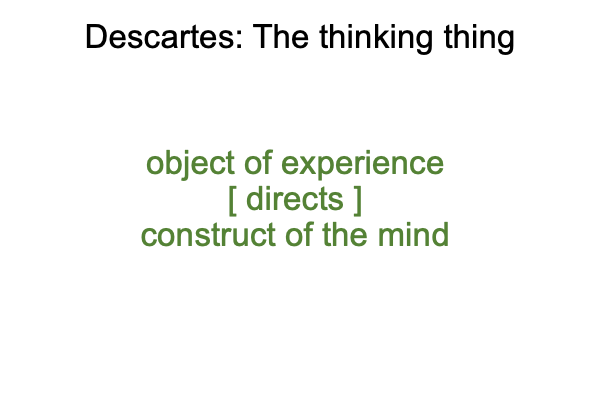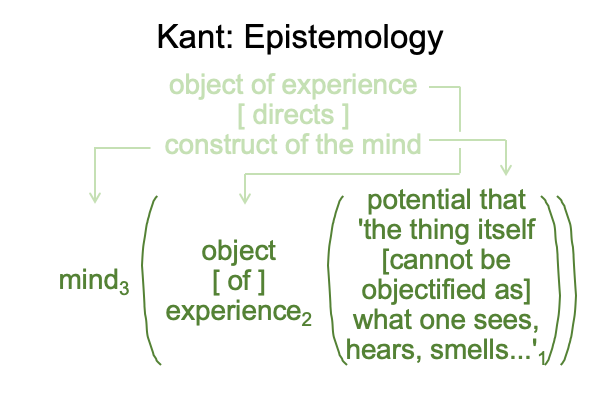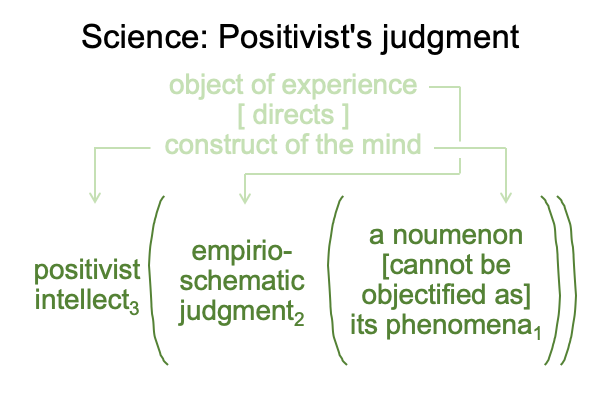Avoiding Babylon and the Quest for the Grail of the Unholy (Part 1 of 1)
0001 The actual title of this blog is Looking at Avoiding Babylon’s 2023 Year in Review Podcast.
0002 One avenue to the podcast is https://spiritustv.com@avoidingbabylon.
At the moment of this writing, these comedic, yet earnest, podcasters are also on youtube and rumble.
0003 The current title employs an Arthurian legend riff, because, if anything, the four interlocutors in this video elaborate a sign-relation specifying what Pope Francis, seemingly simultaneously pope and poseur, means to each one. The appropriate Tarot card is the Hierophant. So, that is what I will label this confluence of fallible human and political position.
0004 In general, the sign is a triadic relation where a sign-vehicle stands for a sign-object in regards to a sign-interpretant.
Here is a picture.

0005 In a specifying sign, a content-based sign-vehicle (SVs) stands for a situation-based sign object (SOs) in regards to the question of what it means to me, operating on the potential of ongoing content (SIs).
The actions of the Hierophant play a prominent role in the year-end review. These actions serve as a specifying sign-vehicle (SVs) that stands for the reviewers drinking from a chalice of unholiness (SOs) in regards to what the news events of 2023 mean to traditional Catholics (SIs).
0006 Here is a picture.

0006 Now, the members of the discussion do not quest for the grail of the unholy. Rather, they suffer it. The elixir that they reluctantly imbibe is a distillate of the rotted fruit of the tree of the knowledge of good and evil, vaporized and condensed by nefarious operators similar to those fingered in Charles Theodore Murr’s book (2022) Murder in the 33rd Degree.
0007 Razie Mah offers two snapshots of this distillate.
One is Looking at Sam Smith and Kim Petras’s Music Video (2022) “Unholy”, presented in Razie Mah’s blog on February 11, 2023, several days after the Grammy awards.
Two is Looking at Carlo Vigano’s Speech (2021) “How the Revolution of Vatican II Serves the New World Order”,presented during July 2022, in the same blog.
This is what the talents at Avoiding Babylon taste.
0008 So, what is this distillate?
Well, the answer is obvious.
The distillate is the liquid in the grail of the unholy.
Surely, the elixir is spiritual. But, it is not the blood of Christ. Its mash is stamped from the modern grapes of alienation and resentment.
0009 At this moment, pause, and take a glance at the title of this blog. The title proposes a quest, not for the distillate, but for the grail of the unholy. The grail is the vessel, the cup, the chalice of what is unholy.
0010 Spoken words are so slippery.
Perhaps, the following articulation is more suitable.
I propose a quest for the doctrine of original sin.
0011 The doctrine of original sin is the vessel of the unholy, purchased by Christ in the transaction of all time, bringing good out of the fall of Adam and Eve.
0012 But, has not Augustine’s doctrine of original sin been disproven by modern science?
This is a very good question.
To witness one Christian author caught in the tentacles of this “has not”, consider Looking at Andrew Ter Ern Loke’s Book (2022) “The Origin of Humanity and Evolution”, appearing in Razie Mah’s blog between November 30 and 1, 2023.
0013 I propose that Avoiding Babylon pose this question to their audience, in an open forum, along with the following queries. (1) Is Augustine’s doctrine of original sin still valid after modern science demonstrates that there is no genetic bottleneck, as would be expected if Adam and Eve are parents of all humans? (2) Does Augustine’s diagnosis of concupiscence still apply? (3) What about other diagnoses, such as the Protestant’s doctrine of total depravity? Do they still apply? Finally, (4) are there any alternate formulations of original sin proposed after Augustine but before the modern Age of Ideas?
0014 I suspect that the answers will be: (1) No. (2) Yes. (3) Yes, look no further than the demos-racket party members and their rino consorts beholden to the glow-baloney-ists. (4) Yes, Thomas Aquinas proposes that original sin is the deprivation of original justice.
0015 In a subsequent open forum, I propose that the audience of Avoiding Babylon riddle this question. Does Aquinas’s proposal that original sin is the deprivation of original justice apply to human evolution?
In other words, is there a twist in human evolution?
Is human evolution shaken, not stirred?
Has the living world of humanity changed?
Is the German word, “Lebenswelt”, appropriate?
What if our current Lebenswelt is not the same as the Lebenswelt that we evolved in?
0016 Why stop there?
Can the Lebenswelt that we evolved in correspond to an era of original justice?
Can our current Lebenswelt correspond to an era of original sin?
0017 Of course, with questions like these, an open forum may descend into chaos. To date, no one seems willing to connect the dots, except for Razie Mah. That give this literary figure a certain daring. He even proposes a label for the transition from the Lebenswelt that we evolved in to our current Lebenswelt.
The label is “the first singularity”.
Yes, there is an archaeology of the fall.
0018 If Aquinas’s concept of original justice applies to the Lebenswelt that we evolved in, then how are we to envision this… um… Edenic existence?
Perhaps, inquirers may consider the lives of newborns, infants, toddlers and young children.
These innocent creatures did not evolve to grow up in civilization, did they?
0019 Two recent blogs by Razie Mah assist in opening the modern mind to the possibility that we evolved to be what children expect us to be, which is nothing like what we adults actually are in today’s unconstrained social complexity.
One is Looking at John Deely’s Book (2010) “Semiotic Animal”, appearing from October 30 to 2, 2023. John Deely (1942-2017 AD) is the only postmodern semiotician buried in the cemetery adjacent to Saint Vincent’s College in Latrobe, Pennsylvania. His last student, Brian Kemple, runs the Lyceum website and is worthy of an interview. So are the contributors to his online journal, Reality.
Two is a series of examinations of the works of Michael Tomasello, recently retired Co-Director of the Max Planck Institute for Evolutionary Anthropology in Leipzig, Germany (and may be living near Duke University in North Carolina). These will appear from March 31 to January 4, 2024 (and will be wrapped into an e-book titled, Comments on Michael Tomasello’s Arc of Inquiry (1999-2019), soon to be available at smashwords and other e-book venues).
0020 So, the question is, “Are these little tykes expecting us to be, who we evolved to be? And, if so, then why do we seem to fail to live up to their expectations, say nothing of our own expectations for ourselves?”
I suspect that Dr. Tomasello might want to take a swing at that hardball question.
0021 Imagine the implications of associating Aquinas’s original justice to the Lebenswelt that we evolved in.
0022 As for our current Lebenswelt of original sin, the prior specifying sign says that Pope Francis, as a premier news maker of 2023 (SVs), stands for traditional Catholics being forced to drink elixir from the grail of the unholy (SOs) in regards to the question of what it means to believers, who are concerned about ongoing events (SIs).
0023 Of course, scientists like to call these news items, “memes”, easily transmitted virus-like units of cultural information. Today, memes are everywhere. They are incessantly broadcast. So if the Hierophant employs memes, then what is the nature of memes?
Here, Looking at Daniel Dennett’s Book (2017) “From Bacteria, to Bach and Back”, appearing in Razie Mah’s blog in December 2023, offers a notion that memes, bits of gossip, pithy justifications of concupiscence, demoralizing proclamations, and label-attaching accusations involve the specifying sign (as already noted) as well as the interventional sign.
0024 The interventional sign?
The interventional sign is like a mirror of the specifying sign.
In a specifying sign-relation, the content-based sign-vehicle (SVs) is picked up by the senses as a mind-independent being. The situation-based sign-object (SOs) is mind-dependent.
In an interventional sign-relation, the content-based sign-object (SOs) is available to the senses as an apparently mind-independent being, which is totally backwards from the specifying sign. The perspective-based sign-vehicle (SVi) is mind-dependent.
0025 For the interventional sign-relation, a perspective-based idea in the mind of someone (or something) (SVi) stands for what the participants sense (SOi) in regards to the content-based question, what is happening, drawing upon the possibility that ‘something’ is happening (SIi).
0026 Here is a picture for the meme at hand.

0027 Note that the sign-object of the interventional sign (SOi) is contiguous with the sign-vehicle of the specifying sign(SVs).
However, the interventional sign-relation is much more difficult to assess than the specifying sign-relation.
0028 The lesson is on display in Avoiding Babylon’s podcast of the year 2023 in review.
The Hierophant offers an elixir that tastes like poison to traditional Catholics and the interlocutors ask what is happening. They cannot figure out the potential of ‘something’ happening’ because they cannot ideate, much less imagine, that the current Hierophant is an object (SOi), called into being by an alien intelligence guiding what is happening and the potential of ‘something’ happening (SIi) in the process of implementing an alien idea, plan or judgment (SVi).
0029 Now, substitute the word, “unholy”, for “alien”.
An unholy idea (SVi) stands for this Hierophant making the news (SOi) in regards to the question of what is happening arising from the potential of ‘something’ happening (SIi).
0030 No, this does not sound like concupiscence.
This sounds like something far more deranged.
0031 Has the Yaltaboath of Modernism found its Voice?
Does the Modern Yaltaboath seek to destroy the chalice of the unholy, which has been disproven, then disregarded, but still retains its power to contain the elixir of whatever idea, plan or judgment that our unconstrained minds can conceive?
Will Avoiding Babylon conduct a quest for original sin?
Will they seek to discover the cup of the unholy capable of containing the juices of Modernism?



